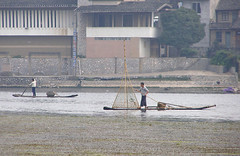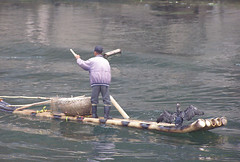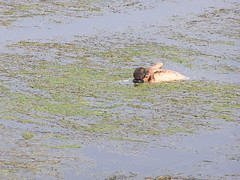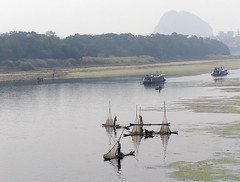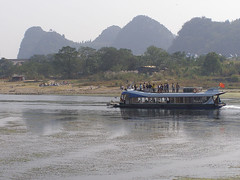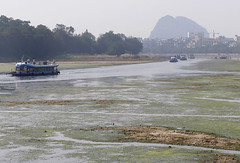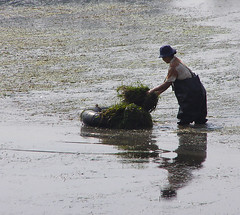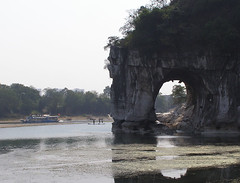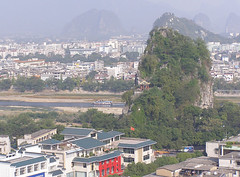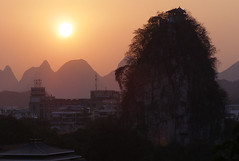The Li River is a small river in Guangxi Province, China, but it runs much larger in Chinese culture. It is most famous for the spectacular karst scenery along its banks between the river towns of Guilin and Yangshuo, the steep haystack mountains that are well-known in Chinese landscape paintings and one of the most treasured topographies in China.
The river flows southward toward the Pearl River, but north of Guilin a canal was built in ancient times, the Ling Canal, constructed in 214 BC, the oldest existing canal in the world. By digging through the low divide between the Li and the Xiang (which flows to the Yangtze), the first emperor of the Qin Dynasty was able to expand his territory and trade southward. Then as now, the central government put enormous resources into controlling the rivers of China.
In October 2007 the Li was low, retreating to a narrow band between wide shallows of mud and weeds. Probably the perfect place to find fish.
Fishermen with funnel-shaped nets worked their way through the weeds on bamboo rafts, while in the open water a cormorant fisherman sent his birds into the river for prey.
The Li River is especially known for this ancient practice. The cormorants are trained from birth to recognize and obey their owner. A narrow band around their necks prevents them from instinctively gobbling the fish they catch, so they bring their prey back to the boat. The fisherman tosses it in the basket and sends the bird out for another. After several dives, the fisherman calls the birds back to rest, and chops one of the fish into small pieces as a reward for the divers.
Meanwhile, close to shore, someone is lurking in the thick weeds.
Its a man armed with a harpoon and a snorkeling mask, covered in slime and crouching in the muck patiently for something to swim by.
Pity the poor fish in the Li River, its a wonder that any of them survive to adulthood. Even the snails among the rocks are good enough to eat in this river.
Up the river, small tour boats are heading upstream. The city of Guilin, like so many cities of China, is booming. This city, however, is known for its parks and quality of life, and the government has recently completed a small lock and channel to connect two lakes to the river, so that these tour boats could make a grand loop of all the sights in town in a couple hours.
A whole train of boats are on their way up river now.
Passing by the fishermen and bathers and one man harvesting weeds. I watched him haul the weeds back to shore in an innertube and pile them on a cargo trike. Are they for eating? Or perhaps just for livestock to eat.
Down the shore a bit there is one of the famous sights of Guilin, called Elephant Rock. Here a karst knob rises directly from the edge of the water, with a little cave worn through its edge that looks like an elephant dipping its trunk in the water. From the right angle anyway. Most of the time the elephant is directly in the river, but when I visited it was a bit high and dry.
From high on top another karst outcrop on the grounds of a Ming Dynasty palace, you could see the sprawl of the city. The fabulous scenery this region is known for, the rugged karst topography of classic Chinese landscape paintings, surrounds this city like an endless scroll, but most of it was lost in the haze of rapid urbanization.
Who wouldn't want to live in such beautiful and fascinating surroundings? But I got the impression that Guilin was being ruined by its own success. Despite its pretty parks and the busy little central square of restaurants, this choking haze of charcoal smoke and auto exhaust was spreading a filth far out into the countryside and cutting the city off from the historic scenery that had made it famous.


